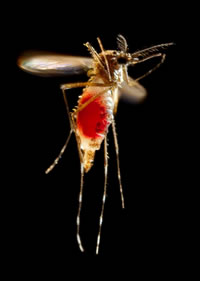The Untold Story of Yellow Fever, the Epidemic That Shaped Our History
The American Plague by Molly Caldwell Crosby: Hardcover, 320 pages, Berkley Books, NY, November 2006; ISBN-13: 978-0425212028; List price $24.95. The book can be purchased at local book stores and through websites such as amazon.com and barnesandnoble.com
 |
| Yellow fever is a virus spread by the mosquito Aedes aegypti. |
| Photo by F. Collins, CDC |
Yellow fever is a virus spread by the mosquito Aedes aegypti. For anyone working in pest control and interested in the history of insect-vectored diseases, this will be an intriguing book.
The American Plague delves into America's not-so-distant past to recount one of the greatest epidemics of our time. It tells the story of the yellow fever epidemic in Memphis, Tennessee...one that would cost more lives than the Chicago fire, San Francisco earthquake and Johnstown flood combined...and it is a narrative journey into Cuba and West Africa, where a handful of doctors would change medical history.
Yellow fever, a virus born of the slave trade, struck 500,000 Americans over two centuries touching every state from Texas to Massachusetts. It would seem by some to be conjured by God and divinely directed, since epidemics struck every country that participated in the slave trade, and passed by those that didn't. Yellow fever paralyzed governments, halted commerce, quarantined cities and altered the outcome of wars. It was not only the gruesome symptoms of the disease-much like those of Ebola today-but the long-term, crippling effect on a place and its people that made it such a dreaded disease and one that the federal government could not ignore.
In 1900, the United States sent three doctors, led by Walter Reed, to Cuba to discover how this disease was spread. Camped on sprawling farmland just outside of Havana, they launched one of history's most controversial human studies. Two of the doctors would be infected; one would die. Two dozen men-veterans of the Spanish-American War-would volunteer to be test subjects. Tragic and terrifying, The American Plague beautifully depicts the story of yellow fever, and its reign in this country. A story that, in the end, is as much about the nature of human beings as it is the nature of disease.
Background Information on Yellow Fever from The American Plague...
"Yellow fever became the most dreaded disease in North America for two hundred years. It did not kill in numbers as high as some of its contemporaries like cholera or smallpox, and it was not contagious; yet it created a panic and fear few other diseases, ancient or contemporary, can elicit.
During its tenure in this country, yellow fever would inflict 500,000 casualties and 100,000 deaths. The fever would stretch the length of North America, afflicting Massachusetts, Rhode Island, New Hampshire, Connecticut, New Jersey, Pennsylvania, New York, Delaware, Maryland, Illinois, Missouri, Ohio, Kentucky, Virginia, North Carolina, South Carolina, Georgia, Alabama, Tennessee, Mississippi, Arkansas, Louisiana, Florida and Texas.
The U.S. capital would move from Philadelphia to Washington, D.C., after a devastating yellow fever epidemic in 1793. Alexander Hamilton suffered the fever, while George Washington, John Adams and Thomas Jefferson fled the city; the United States government was paralyzed.
In New York, Greenwich Village would become known as "the Village" because it was the safe haven outside of the city during yellow fever epidemics.
Napoleon would abandon his conquests in North America after losing 23,000 of his troops to yellow fever in the colony of Haiti. He made a hasty and fearful retreat from this pestilent hemisphere, selling his large Louisiana holdings for cheap to Thomas Jefferson.
During the Civil War, yellow fever would serve as one of this country's first forms of biological warfare. And the Spanish-American War, at the close of the nineteenth century, would be fought more against this fever than against the Spanish.
For the first century of its siege in the United States, yellow fever marked for destruction the heavily populated, northern port cities of Boston, New York and Philadelphia. Then, in 1807, the Atlantic slave trade was abolished, and the fever suddenly retreated from the North. By 1850, no other epidemics of yellow fever would occur in those major cities. As the North weaned itself from the slave trade, its southern counterpart absorbed the slave labor and the accompanying yellow fever. In the South, where slavery became deeply entrenched, yellow fever found its lifeblood."

